
Gongora, abbreviated Gga in horticultural trade, is a member of the orchid family (Orchidaceae). It consists of 65 species known from Central America, Trinidad, and tropical South America, with most species found in Colombia. They grow across a wide geographical range, from wet forests at sea level, to mountainous regions in the Andes, as high as 1,800 m.

Chusquea is a genus of evergreen bamboos in the grass family. Most of them are native to mountain habitats in Latin America, from Mexico to southern Chile and Argentina.

Catasetum, abbreviated as Ctsm. in horticultural trade, is a genus of showy epiphytic Orchids, family Orchidaceae, subfamily Epidendroideae, tribe Cymbidieae, subtribe Catasetinae, with currently 200 accepted species, many of which are highly prized in horticulture.

Mandevilla is a genus of tropical and subtropical flowering vines belonging to the family Apocynaceae. It was first described as a genus in 1840. A common name is rocktrumpet.

Clethra is a genus of flowering shrubs or small trees described as a genus by Linnaeus in 1753.

Vriesea is a genus of flowering plants in the botanical family Bromeliaceae, subfamily Tillandsioideae. The genus name is for Willem Hendrik de Vriese, Dutch botanist, physician (1806–1862). Its species are widespread over Mexico, Central America, South America and the West Indies.

Weinmannia is a genus of trees and shrubs in the family Cunoniaceae. It contains 90 species, which range from Mexico through Central and South America including the Caribbean, and to the Mascarene Islands in the western Indian Ocean. It is absent from mainland Africa and Australia, but some fossils have been attributed to Weinmannia in Australia.

Dracontium is a genus of flowering plants similar to those of Amorphophallus. Unlike Amorphophallus which is found in the Old World, this genus has a New World distribution and is native to South America, Central America, southern Mexico, and the West Indies.

Pitcairnia is a genus of plants in the family Bromeliaceae, subfamily Pitcairnioideae. It was named for William Pitcairn, Scottish physician and gardener (1711–1791). The genus Pitcairnia ranks as the second most prolific of the bromeliad family. They are most abundant in Colombia, Peru and Brazil, but can also be found in areas from Cuba and Mexico south to Argentina. One species, Pitcairnia feliciana, is found in tropical West Africa and is the only member of the family Bromeliaceae not native to the Americas.

Brunellia is a genus of trees. They are distributed in the mountainous regions of southern Mexico, Central America, West Indies, and South America. Brunellia is the only genus in the family Brunelliaceae. As of 2001 there were about 54 species.

Hedyosmum is a genus of flowering plants in the family Chloranthaceae. There are about 40 to 45 species. They are distributed in Central and South America and the West Indies, and one species also occurs in southeastern Asia. They are mostly dioecious, except for H. nutans and H. brenesii which are exclusively monoecious, and H. scaberrimum and H. costaricense with both monoecious and dioecious individuals.

The following outline is provided as an overview of and topical guide to South America.
Palmorchis is a genus of flowering plants from the orchid family, Orchidaceae. It is native to South America, Central America and Trinidad.
- Palmorchis caxiuanensisRocha, S.S.Almeida & Freitas - Pará
- Palmorchis colombianaGaray - Colombia
- Palmorchis deceptoriusVeyret & Szlach. - Colombia
- Palmorchis duckeiHoehne - Brazil
- Palmorchis eidaeDressler - Costa Rica
- Palmorchis guianensis(Schltr.) C.Schweinf. & Correll - Brazil, Venezuela, the Guianas
- Palmorchis imuyaensisDodson & G.A.Romero - Ecuador
- Palmorchis lobulata(Mansf.) C.Schweinf. & Correll - French Guiana, Ecuador, Peru
- Palmorchis nitidaDressler - Costa Rica, Panama
- Palmorchis pabstiiVeyret - French Guiana
- Palmorchis paludicolaDressler - Costa Rica
- Palmorchis pandurataC.Schweinf. & Correll - Ecuador
- Palmorchis powellii(Ames) C.Schweinf. & Correll - Costa Rica, Panama
- Palmorchis prospectorumVeyret - French Guiana, Suriname
- Palmorchis puber(Cogn.) Garay - Brazil, Venezuela
- Palmorchis pubescentisBarb.Rodr. - French Guiana, Suriname, Brazil, Venezuela, Trinidad
- Palmorchis silvicolaL.O.Williams - Costa Rica, Ecuador
- Palmorchis sobralioidesBarb.Rodr. - Ecuador, Brazil
- Palmorchis sordidaDressler - Costa Rica
- Palmorchis trilobulataL.O.Williams - Nicaragua, Costa Rica, Panama, Suriname, Ecuador
- Palmorchis trinotataDressler - Panama

Callithomia lenea is a species of butterfly of the family Nymphalidae. It is found in Central and South America.

Hypothyris lycaste is a species of butterfly of the family Nymphalidae. It is found in Central and northern South America.

Ithomia avella is a Neotropical species of butterfly of the family Nymphalidae.

Tithorea harmonia, the Harmonia tiger-wing or Harmonia tiger, is a species of butterfly belonging to the family Nymphalidae.

Hyalyris is a genus of clearwing (ithomiine) butterflies, named by Jean Baptiste Boisduval in 1870. They are in the brush-footed butterfly family, Nymphalidae.
Euterpe catinga is a palm species in the genus Euterpe. It is found in forests of a dry, sandy soil and very peculiar vegetation, known as catinga forests or Campinarana in northern South America.

















